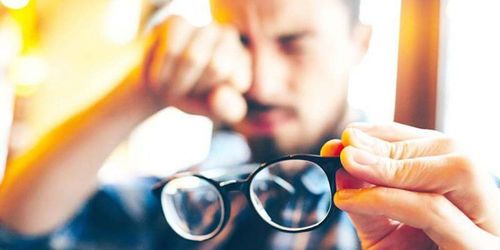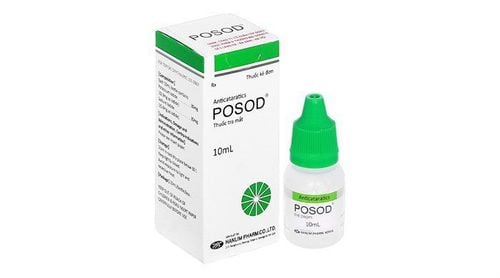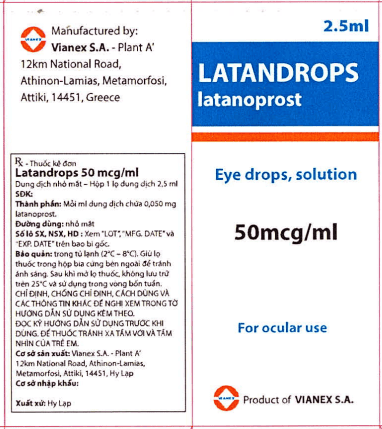This is an automatically translated article.
The article was professionally consulted by an eye doctor - Department of Examination & Internal Medicine - Vinmec Hai Phong International General HospitalMyopia is one of the most common refractive errors in recent years, especially in school age. Mostly because children are exposed to electronic devices too early, rarely participate in outdoor activities.
1. Causes of myopia
The eye has two parts that help to see things around it:
Cornea: This is a thin, transparent layer of tissue that lies in front of the eye's surface. Lens: A clear structure, the size and shape of the eye lens. shaped like an M&M candy. A normally shaped eye will have a smooth curvature, like the surface of a marble. Only when the cornea and lens have such curvature (refraction) can light come to form a clearly focused image on the retina, the back part of the eye.
1.1 Myopia If the cornea or lens has an irregular and smooth curvature, light rays cannot reach the retina properly, causing refractive errors. Myopia occurs when the cornea is too curved, so that light does not enter the retina, but focuses in front of the retina, resulting in blurred vision when at a distance.
1.2 Other refractive errors In addition to myopia, there are several other refractive errors that include:
Farsightedness: In contrast to nearsightedness, farsightedness occurs when the eyeball is shorter than normal or the cornea is curved too little. . In adults with presbyopia, both near and far objects are blurred. Astigmatism: Astigmatism occurs when the cornea or lens of one eye is more curved than the other. Astigmatism does not cause blurred vision.
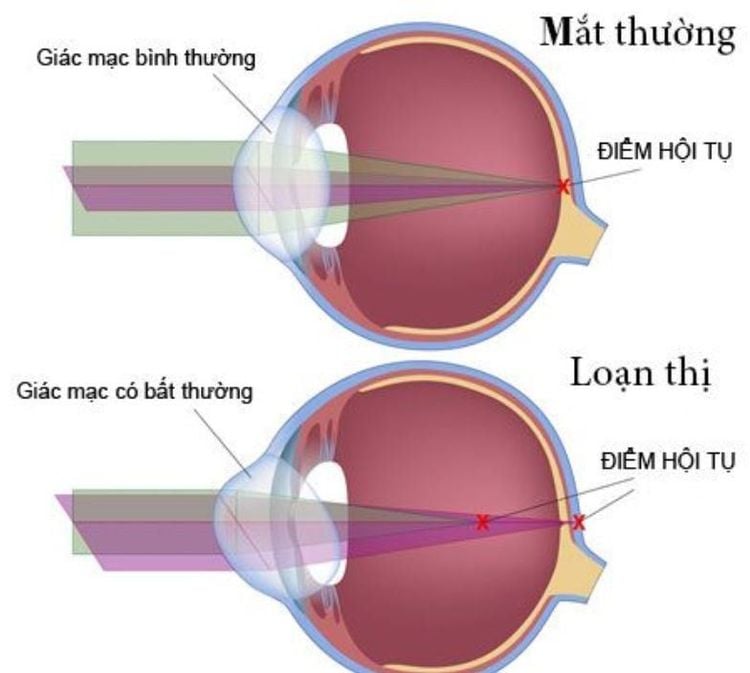
Loạn thị gây ảnh hưởng đến tầm nhìn của người bệnh
2. Symptoms of myopia
Symptoms of myopia may include:
Blurry vision when looking at distant objects Need to squint or partially close eyelids to see clearly Headaches from eye strain Difficulty seeing when driving, especially in nocturnal myopia (nocturnal myopia) Myopia often appears early, especially in young children sitting in school chairs. Children with nearsightedness have:
Persistent squinting Needs to sit closer to the TV, movie screen or front of the classroom Can't seem to see clearly distant objects Blinking excessively Rubbing eyes often
3. When should I go to an eye doctor if I am nearsighted?
You should see a doctor when your vision is so blurred that it affects your daily and work activities; decreased interest in group activities. Your doctor will help you determine your degree of nearsightedness and advise you on options for correcting your vision. Also, you should seek emergency medical attention when:Sudden onset sudden small spots in front of your eyes as you observe your surroundings Flashes of light in one or both eyes Small shadow-like marks on the eyes

Khi người bệnh xuất hiện đột ngột các đốm nhỏ trước mắt cần đi khám bác sĩ ngay
These are warning signs of retinal detachment, a rare complication of nearsightedness. Retinal detachment is an emergency because early detection and treatment are critical.
4. When does a normal person go for an eye exam?
The American Academy of Ophthalmology recommends the following times for regular eye exams:
4.1 Adults If you are at high risk for certain eye conditions such as glaucoma, you should have your eyes checked. Have your eyes checked every 1-2 years, starting at age 40. If you don't have any eye disease, you are advised to have an eye exam at the following intervals:
Every 5 - 10 years in your 20s to 30 Every 2 - 4 years at ages 40 to 54 Every 1 - 3 years between ages 55 to 64 Every 1 - 2 years after age 65 If you wear glasses or contact lenses, have a medical condition Eye complications such as diabetes should be checked regularly. When you visit your eye doctor, ask your doctor about the schedule for your next visit or visit at any time when signs of eye abnormalities appear.
4.2 Children and adolescents Children should be screened for eye disease and have their vision checked by a pediatrician, ophthalmologist, or other trained screener at the following ages and time periods.

Trẻ em cần kiểm tra thị lực giúp đánh giá tình trạng sức khoẻ của mắt
6 months old 3 years Before 6 years old and every 2 years in school, in person at home or in public.
5. Who is prone to myopia?
Several risk factors increase the likelihood of developing myopia, such as:
Genetics: Myopia tends to run in families. If one parent is nearsighted, the child has a higher risk of myopia than other families. The risk is even higher if both parents are nearsighted. Environmental conditions: Lack of time outdoors increases the risk of myopia. Children who watch a lot of TV, watch a lot of phones have a higher risk of nearsightedness than other children. Therefore, it is important to get rid of smartphone addiction for children.
6. Complications of nearsightedness
Myopia is associated with a range of complications from mild to severe such as:Reduced quality of life: Untreated myopia can affect quality of life. You may become less socially engaged after having difficulty performing some tasks. Eye strain: Untreated nearsightedness can cause you to squint or strain your eyes to maintain focus. This can lead to eye strain and headaches. Reduced safety: Vision problems can affect your safety, especially when engaging in activities such as driving or operating heavy equipment. Financial burden: The cost of lens corrections, eye exams, and medical treatment can become a financial burden. Vision loss can also affect your job, your main source of income.
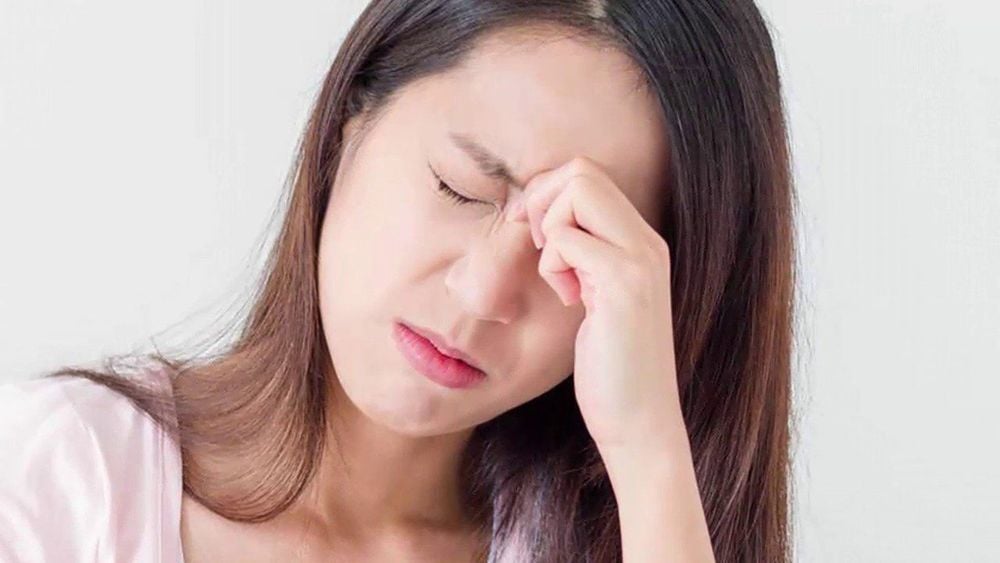
Biến chứng của tật cận thị có thể gây triệu chứng mỏi mắt ở người bẹnhe
In addition to retinal degeneration, people with severe myopia are also at risk for retinal detachment, glaucoma, cataracts and polycythemia vera - damage to the central retina. Tissue in the long eyeball is stretched and thinned, causing tearing, inflammation, weak blood vessels, easy bleeding, and scarring. Therefore, patients need to know the causes and symptoms of myopia in order to have appropriate examination and treatment directions.
Eye specialist at Vinmec has comprehensive vision and eye health care functions for children, adults and the elderly including: refractive error check, laser treatment and surgery. In addition, the department also has the task of coordinating with other clinical departments in the treatment of pathological complications and eye injuries caused by accidents.
In addition, the team of Ophthalmologists at Vinmec are experienced doctors who have performed many types of surgery from routine to difficult surgeries, especially techniques that require aesthetics. With enthusiasm and love for the profession, the team of doctors working at Vinmec always gives customers the best services with the highest service quality.
Especially, now to improve service quality, Vinmec International General Hospital has vision-related service packages such as:
Refractive error screening package Cataract surgery consultation and examination package Ortho-K package
Please dial HOTLINE for more information or register for an appointment HERE. Download MyVinmec app to make appointments faster and to manage your bookings easily.
Reference source: mayoclinic.org




